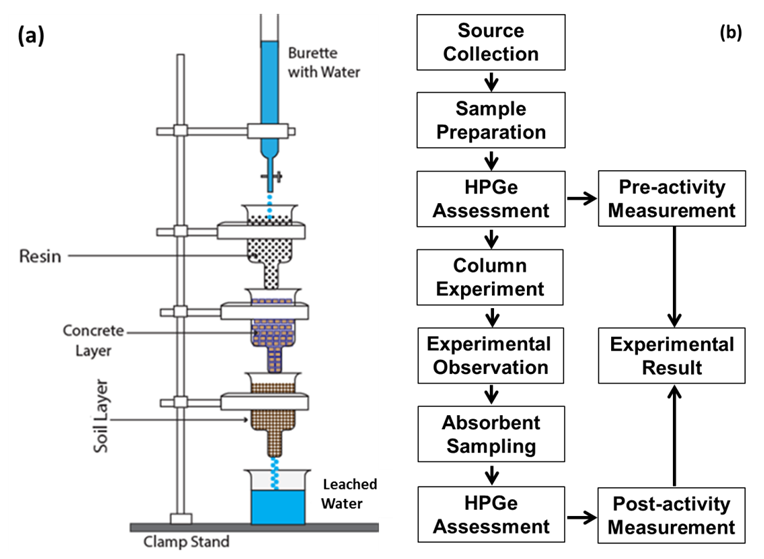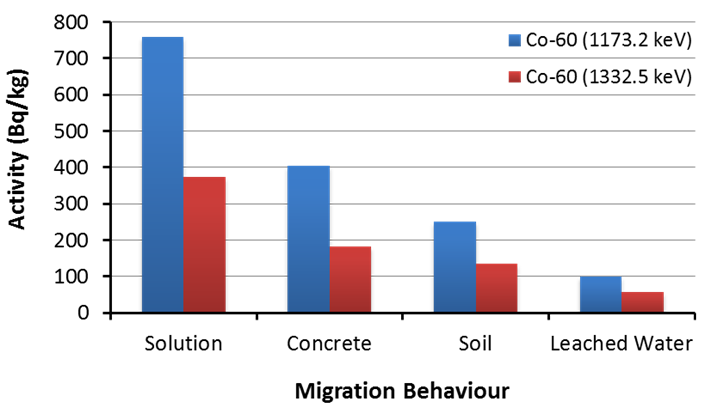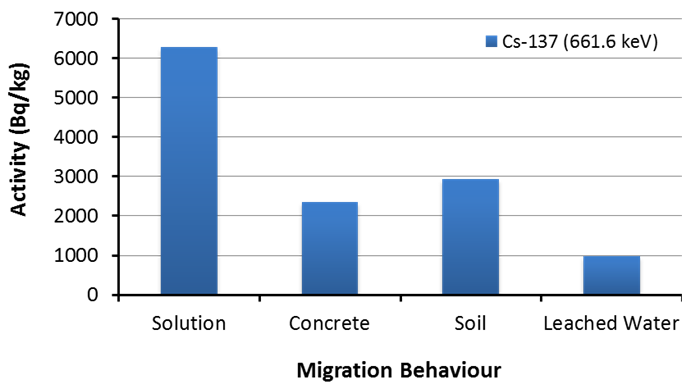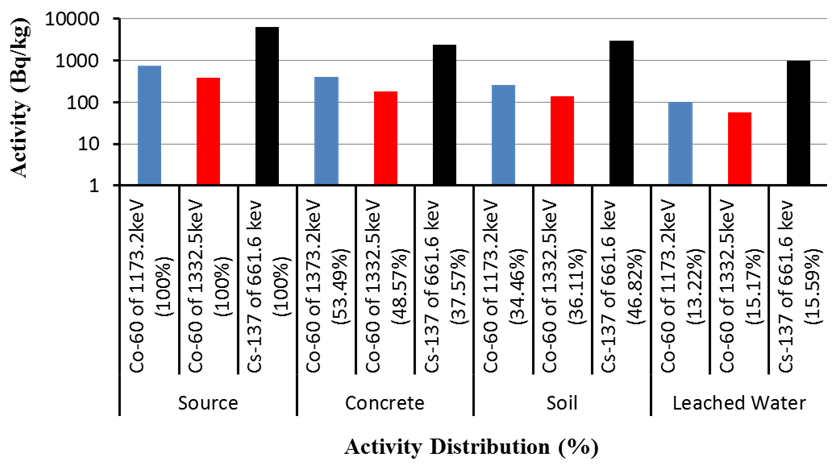-
Paper Information
- Paper Submission
-
Journal Information
- About This Journal
- Editorial Board
- Current Issue
- Archive
- Author Guidelines
- Contact Us
American Journal of Environmental Engineering
p-ISSN: 2166-4633 e-ISSN: 2166-465X
2018; 8(1): 11-16
doi:10.5923/j.ajee.20180801.03

Radionuclide Adsorption Performance in Cement and Soil Medium for Safety Issue of Radioactive Waste Disposal Facility
M. Shamsuzzaman1, Antu Biswas2, Md. Mosharraf Hossain Bhuiyan1, Md. Abu Haydar1, Debasish Paul1, Md. Jafor Dewan2, Md. Shafiqul Islam2
1Health Physics and Radioactive Waste Management Unit, Institute of Nuclear Science and Technology, Atomic Energy Research Establishment, Dhaka, Bangladesh
2Department of Nuclear Engineering, University of Dhaka, Dhaka, Bangladesh
Correspondence to: M. Shamsuzzaman, Health Physics and Radioactive Waste Management Unit, Institute of Nuclear Science and Technology, Atomic Energy Research Establishment, Dhaka, Bangladesh.
| Email: |  |
Copyright © 2018 The Author(s). Published by Scientific & Academic Publishing.
This work is licensed under the Creative Commons Attribution International License (CC BY).
http://creativecommons.org/licenses/by/4.0/

Radionuclide migration from a disposal facility is one of the most crucial factors for protecting man and environment. To ensure safety of a disposal facility, radionuclide migration or adsorption behavior is a key issue in operational and post operational phase. In this perspective, laboratory based column experiments was carried out to investigate theadsorption behavior of radionuclide on the cement and soil mediums. Present experiments simulate the migration behavior of radionuclide through the cement and soil barrier into the environment if the waste packs inside a disposal site encounter rain infiltration. In this study, some simulant cement chunk was produced with a water-cement ratio of 0.50 each, and soil samples were prepared with various grain sizes from 90 µm to 2 mm. In this study adsorption and hence migration behavior of solid spent resin was verified experimentally. In addition, adsorption of two radionuclides, namely 60Co and 137Cs was investigated as liquid waste by using the gamma spectrometry analysis. The highest activity distribution of 60Co at 1173.2 keV and 137Cs was found in concrete medium 53.49%, and 46.82 in the soil medium, respectively. Thus, locally prepared multiple barriers of cement and soil medium could reasonably be suitable for liquid waste immobilization.
Keywords: Adsorption, Migration, Disposal, Spent resin, Cobalt-60, Cesium-137
Cite this paper: M. Shamsuzzaman, Antu Biswas, Md. Mosharraf Hossain Bhuiyan, Md. Abu Haydar, Debasish Paul, Md. Jafor Dewan, Md. Shafiqul Islam, Radionuclide Adsorption Performance in Cement and Soil Medium for Safety Issue of Radioactive Waste Disposal Facility, American Journal of Environmental Engineering, Vol. 8 No. 1, 2018, pp. 11-16. doi: 10.5923/j.ajee.20180801.03.
Article Outline
1. Introduction
- Near-surface repositories are accepted publicly in many countries as a good option for low or intermediate level radioactive waste (L/ILW) disposal that generates at nuclear power plants [1]. The concept of secure isolation criteria of the waste in repository development has enhanced the confidence in the feasibility of safe disposal. The safety evaluation of these repository concepts on radionuclide migration behavior has been demonstrated through rigorous safety assessment methods, development of safety technics and independent review of these assessments [2]. Migration of radionuclides in a wet geological formation and engineered barrier is one of the most important factors to be considered for safety evaluation of a radioactive waste disposal facility [3, 4]. This is particularly important for Bangladesh due to high precipitation rate, as it potentially cause the release of radionuclides from shallow land disposal of L/ILW into clayey soil formation in the natural geological environment [5]. This is because, excessive precipitation promotes radionuclide release from shallow land disposal to the engineered barrier, and consequently the clayey soil of natural geological formation can raise potential safety concern. The operational safety and post-closure safety of a disposal facility needs to be ensured for the safety of the public and environment. Operational safety is provided by means of engineered features and operational controls. Post-closure safety is provided by means of engineered and geological barriers; it does not depend on monitoring or institutional controls after the facility has been closed. That is, a facility needs to design to be passively safe [6]. Thus, understanding of the performance of this type of disposal system and its safety features and processes needs to be investigated based on the experimental observation and scientific knowledge [7].Nowadays, L/ILW is generating from various facilities across the country, including the TRIGA Mark-II Research Reactor (RR) of Bangladesh Atomic Energy Commission (BAEC). In RR facility, ion exchanging resin is commonly used in resign column to adsorb radio-elements from primary coolant circuit, and eventually resign makes themselves a radioactive waste [8]. Generally, spent resin is considered as L/ILW, and hence it can be disposed near surface level. During the operation of RR, L/ILW is generally produced. These wastes should be properly treated and disposed in order to minimize the potential hazards of environments. In this regard a cost effective retarding materials was prepared by using locally available cement to introduce in the near surface disposal concept in order to minimize the disposal cost. In addition, clayey soil layer was used in the present study to investigate its retarding capacity as a backfilling medium. The performance of the retarding materials was verified by passing fresh water through spent resin, and then through the retarding materials to check the radionuclide adsorption. A similar technique was used to verify adsorption behavior of the retarding materials while liquid solution of 60Co and 137Cs were passed through column. In this study, Madhupur clay collected from Gajipur district of Bangladesh and locally made cement blocks were used in the column experiments as the barrier material. Madhupur clay is highly weathered, brownish red to brick red clay. It is sticky, inter-bedded with fine sand and silt and contains ferruginous concretions and ferruginous and calcareous Madhupur nodules. The barrier effectiveness of this clayey soil was verified in a laboratory based column experiments focusing on the rain fall condition. Cemented blocks were used as an engineered barrier to be useful in a near surface disposal facility. Failure of engineered barrier will lead the radionuclide release into the host soil medium. Keeping this in mind, present study of radionuclide adsorption and hence migration behavior was performed in the aforesaid two mediums. The prime objective of this paper is to characterize the local soil to be useful as a potential backfilling medium and to prepare a cost effective cemented engineered barrier for retardation of nuclides, if get released from a prospective near surface repository in case of rain infiltration. The scope of this research work incorporates the safety evaluation methodologies for shallow land disposal concept in clayey soil formation. In this regard solid spent resin, 137Cs and 60Co radioisotopes have been selected as a simulant radioactive waste to analyze their migration, and hence adsorption behavior in local soil and cement matrix for the safety performance of a potential disposal site in Bangladesh.
2. Materials and Methods
2.1. Sample Collection and Preparation
- Ion exchanging AMBERLITE IRN150 radioactive spent resin sample was collected from the onsite interim of RR facility. Spent resin samples of total weight 300 g were collected in a plastic container. Then, resin sample was distributed into three plastic pots with 95.68 g each for each experimental run. During sample collection the dose rate of the resin sample was found to be 68 µSv/h, and surface activity concentration level was 46 Bq/cm2. To prepare the standard solution of 60Co and 137Cs, some samples of 0.125 mg were collected from the sealed vial using micro-pipette that was stored in a pit source room of central radioactive waste processing and storage facility (CWPSF). The collected samples are then diluted by adding the normal tap water for experimental run. The activity concentration of all the collected samples was characterized by using the high purity germanium (HPGe) detector. Soil samples were collected from Madhupur tract of Joydebpur. This soil is known as deep red-brown terrace soil which contributes about 1.54% of total soil in Bangladesh. The grain sizes of each soil sample were measured by using the sieve technique. Then, soils of various grain sizes were mixed up to ensure the multiple size particle content in each soil sample. The properties of characterized soil samples are presented in Table 1.
|
|
2.2. Activity Calculation of Samples
- The initial activity concentration of each sample spent resign and liquid solution was measured prior to perform the respective experimental run. Then, in each experimental run with spent resin fresh water was passed through the soil and cement medium inside the experimental column. In the course of the experimental progression, activity gained in the column medium due to migrated radionuclide from the solution to the concrete and soil medium. After completion of each experimental run the moisten soil and concrete samples were collected, and activity was measured by the HPGe detector. The leached out (i.e., passed out) residual water was collected to measure its gained activity by the same method. For this purpose, a HPGe detector of 40% efficiency and 2 KeV resolution (at 1.33MeV) was used. The activity concentration is calculated based on the following equation (1),
 | (1) |
 = Activity concentration of the sample in Bq.kg-1;
= Activity concentration of the sample in Bq.kg-1; = Net count per second (CPS of each sample – CPS of background value);
= Net count per second (CPS of each sample – CPS of background value); = % counting efficiency;
= % counting efficiency; = Weight of the sample in g;
= Weight of the sample in g;  = Absolute intensity of the gamma ray;The standard deviation of the detector’s counts was estimated by the following equation (2)
= Absolute intensity of the gamma ray;The standard deviation of the detector’s counts was estimated by the following equation (2) | (2) |
 = Counts measured in time Ta;
= Counts measured in time Ta; = Background measured in time Tb.
= Background measured in time Tb.2.3. Experimental Procedure
- Laboratory based column experiments was performed to verify the adsorption behavior of radionuclides in the soil and cement medium. The experimental setup and flow diagram with various processing steps are shown in Fig. 1 (a) and (b). In this column experiments, gravity driven discharge of fresh tap water was passed through the radioactive spent resign layer, and successively through the concrete and soil layers. In the experimental runs with Cobalt-60 (60Co) and Cesium-137 (137Cs) sources, their radioactive solution was directly passed through the studied mediums. Throughout the experiment, water flow rate of around 0.028 mls-1 was maintained by using the stopping knob of a burette. In this study, Madhupur clays were used as soil layer to simulate the backfilling material of a potential repository. Cement chunks were used in the experimental column to simulate the nuclide adsorption behavior in the cemented engineered barrier system (EBS) of a repository. Locally manufactured EBS was used in experiments as an absorbent structure to verify its capacity to limit the migration of radionuclides caused by groundwater pathway. In this study, simplified laboratory based column experimental technique was used to evaluate the radionuclide immobilization and migration behavior in some potential host, and EBS medium, such as soil layer, and cemented medium. In the experiments, a series of column runs were performed for the radioactive spent resin, and liquid solution of 60Co and 137Cs sources. To prepare the experimental columns, resign samples were collected from the onsite interim of Research Reactor facility, where radioactive spent resin was safely stored for the future disposal. Standard liquid solution of 60Co and 137Cs were prepared from their concentrated solution that was collected for R&D purposes from the pit sources of (CWPSF). Consequently, column experiments were performed with the prepared liquid solution of 60Co and 137Cs to analyze their adsorption behavior in the studied medium. In the column experiments, fresh water was passed through the concrete and soil layers, and then leached out water was collected from the lower part of the column matrix. The concrete chunks were used in the experiments as a simulant of the EBS absorbent that were prepared with the water-cement ratio of 0.50. In the soil layer of the experimental column, Madhupur clay was used which is deep red-brown terrace soil and collected from Madhupur tract of Joydebpur in Gajipur district of Bangladesh. After completing each experimental run, the activity concentration in each part of the column was estimated. In this purpose, HPGe detector was used to analyze the radionuclide adsorption affinity of cement and soil medium. Consequently, the differences in adsorbed activity of each layer in the column were detected.The experimental procedures are presented in a flow diagram as shown in Fig. 1(b). This diagram describes the various procedures involved in the experimental runs. These procedures were followed in every experimental run with radioactive spent resin, 60Co and 137Cs sources.
 | Figure 1. (a) Experimental setup for the column experiments, (b) Flow diagram of the overall experimental steps |
3. Result and Discussion
3.1. Assessment of Adsorption for Spent Resign
- The initial activity concentration of the resin sample was measured prior to perform the respective experimental run. The observed activity concentration in spent resin is presented in Fig 2. From this graph it is evident that no radionuclide dissolution occurred during water flow through the radioactive resin to the soil and cement medium in the column. This observation indicates that spent resin can safely be disposed in a simplified cost effective manner in a near surface repository without any imposing any significant risk to the environment.
 | Figure 2. Adsorption characteristic of radionuclide from spent resin |
3.2. Assessment of Adsorption for 60Co Solution
- The adsorption behavior of the 60Co nuclide is important in the case of assessment of a disposal facility due to the presence of 60Co in the nuclear reactor’s waste stream. Although dissolution of 60Co nuclide was not observed in spite of its presence in the spent resin, however, it needs to evaluate the adsorption behavior of 60Co nuclide. Thus, the confirmation check of the migration behavior, and hence the adsorption affinity of 60C was further verified with liquid 60Co source. For this purpose, experiments were performed with gravity driven discharge of liquid 60Co solution through the experimental column materials. The leached out water then collected in a pot and its activity was analyzed. In this experiments, the activity level of 60Co isotope in the entire column mediums was analyzed in terms of the activity counts of two separate energy peaks as 60Co radioisotope possess two energy peaks. The activity concentration of 60Co at 1173.2 keV was found relatively higher than that of 1332.5 keV in all the column materials. The activity concentration of the initial solution was gradually reduced when it passed through the concrete and soil medium in the experimental runs. After each experiment, the activity concentration of the column materials and the leached out water was analyzed to quantify the variation of adsorbed activity concentration in the respective medium. Relatively low activity concentration in the leached out water indicates a considerable adsorption in the concrete and soil medium. A descending trend of the activity concentration in the column materials (i.e., concrete, soil and leached out water) was observed, as shown in Fig.3.
 | Figure 3. Migration characteristic of 60Co in adsorbents and leached water |
3.3. Assessment of Adsorption for 60Cs Solution
- To verify the adsorption affinity of 137Cs in a similar manner of 60Co, column experiments were performed with the standard active solution of 137Cs. The activity concentration of 137Cs in various medium is presented in Fig. 4. From this graphical view, the activity concentration of 137Cs in the soil medium was found relatively higher than that of the concrete medium. The comparative assessment of the activity level between the concrete and soil medium indicates an adsorption affinity of 137Cs in the soil medium. Relatively low activity concentration in the leached out water indicates a considerable adsorption in the concrete and soil medium.
 | Figure 4. Migration characteristic of 137Cs in adsorbents and leached water |
3.4. Activity Distribution of 137Cs, 60Co in the Absorbents
- The comparative adsorption behavior of 60Co and 137Cs radionuclide was assessed to verify the variation of adsorption affinity in the soil and cement layers, as shown in Fig. 5. From this graphical view it is recognizable that the adsorption affinity of 60Co is relatively low in concrete medium than that of 137Cs. The highest activity distribution of 60Co (1173.2 keV) was found to be 53.49% in concrete. In the case of 137Cs adsorption behavior, relative adsorption affinity in soil medium was found higher than that of the 60Co nuclide. The highest activity distribution of 137Cs was found to be 46.82% in the soil medium. The activity concentration in the leached out water was found relatively low for both 137Cs and 60Co in all the experiments. The highest activity distribution in the leached out water was found to be 15.17% and 15.59% for 60Co and 137Cs, respectively. This indicates relatively good adsorption capacity of the radionuclides in the studied mediums. In general observation, the distribution of activity concentration in the column materials indicates a variable adsorption affinity of the respective nuclides.
 | Figure 5. Activity distribution of 60Co and 137Cs in different layer of the column |
4. Conclusions
- Radionuclide-release was not identified from the spent resin in the present column materials. Thus, non-migration of radionuclide from the spent resin indicates no radionuclide dissolution. This observation indicates that the disposal of the spent resin used in the primary coolant circuit of the research reactor could be managed in a cost effective simplified cementation method. The migration, and hence adsorption of 137Cs and 60Co in the cemented and soil medium has been observed. This indicates radionuclide adsorption characteristic of the soil and cemented materials. Thus, cemented engineered barrier could be useful for the retardation of the L/ILW in a near surface disposal facility. The soil medium exhibits a good capacity of radionuclide adsorption, and hence can potentially be useful as a backfilling material for a disposal facility. The present experiments indicate relative low release of radionuclide in the leached water. Thus, concept of combined adsorption in the soil and cemented material could be useful to achieve a good retarding capacity for slow down the radionuclide migration in the biosphere to ensure the environmental safety. The methodical approach and experimental views of the present study could be useful for the preliminary safety assessment of a candidate site for a near surface repository.
 Abstract
Abstract Reference
Reference Full-Text PDF
Full-Text PDF Full-text HTML
Full-text HTML
